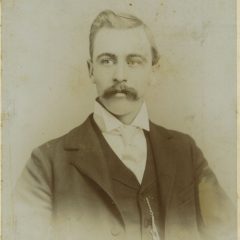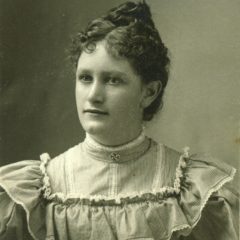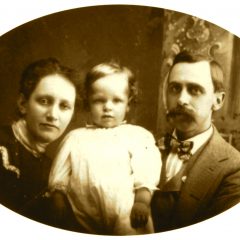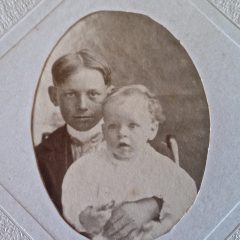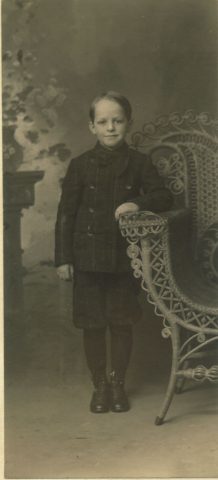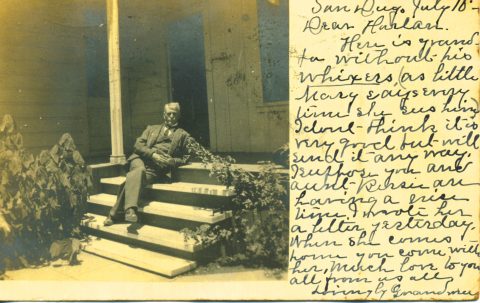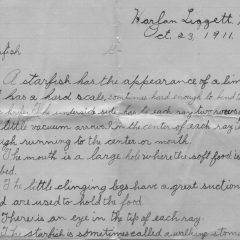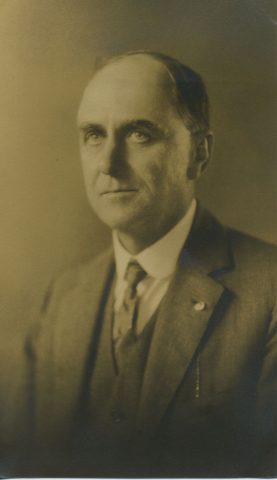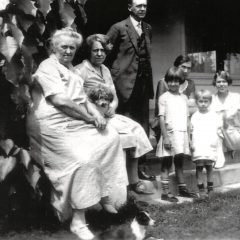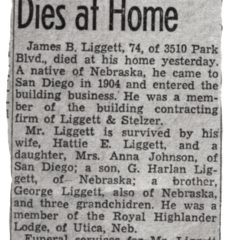To: West to Colorado and California in the 1900s
Sunny San Diego, California, was a popular destination for the citizens of Utica, Nebraska, where a number of of Uticans and ex-Uticans has almost their own colony, especially in the winter months. The December 7, 1895 edition of the Utica Sun said that W.F. Himes sold four tickets to California Thursday… Mr. and Mrs. Geo Liggett, son and grandson Geo. and (grandson) Ralph Hurlburt and A.L. Snyder left for San Diego, California to spend the winter. Mr. and Mrs. George Liggett’s first son, James Bela (J.B.) went to San Diego two years later to marry Jennie Olivia Warriner, at the home of her parents on July 29, 1897.
Jennie was born November 15, 1874, in Red Oak, Iowa, to Lucy A. Ware and Harlan Bush Warriner (pictured below on the right with his brother, Austin Henry, and sister, Anna).
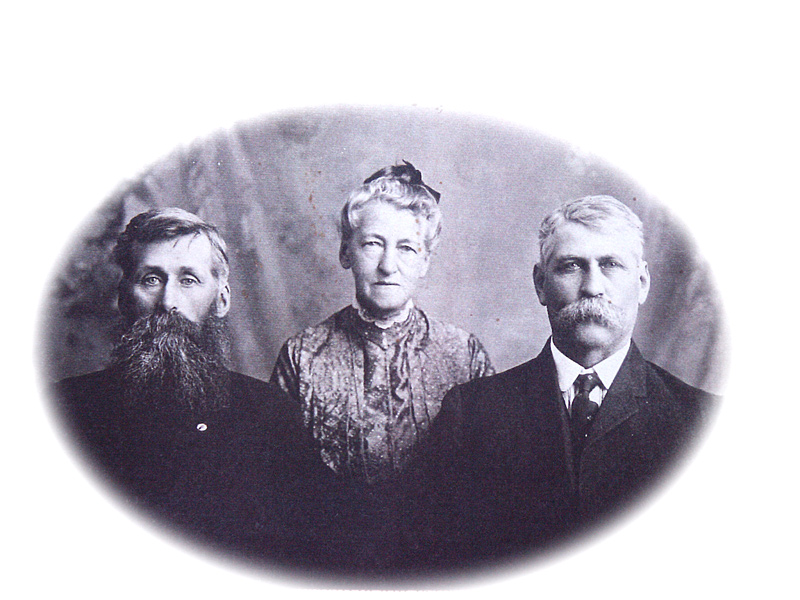
Both of English origin, Harlan was a descendant of William Warriner, pioneer settler of Springfield, Mass. in 1638. Harlan’s parents, pictured below, were Henry and Olivia Ware Warriner.
Lucy was a milliner and Harlan was a business merchant. Jennie was only 6 months old when her family moved to Riverton, NE. By the time her brother, Harry Hastings, was born in 1881, they were living in Naponee, NE. By 1892, the family was living in Utica, when Jennie Warriner was one of the first three tenth grade graduates of the “Big White Frame” school building (pictured below). The family had a store in Utica called Warriner and Co. and sold it to Oscar Thygeson when they moved to San Diego.
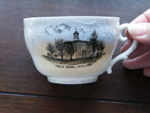
The day after they were married in San Diego, Jim and Jennie Liggett (pictured right) returned to Utica, Nebraska, to make their home. The July 3, 1897 edition of the Utica Sun noted that they expected to be on the road about two weeks, remaining in Denver a short time. “The bride and groom are very well known and highly respected in this vicinity and The Sun joins with their many friends in wishing them a world of happiness.
The Warriner women had an ear for music. Jennie’s sister, Bessie Clare Young, could go to a musical program and play it back at home on the piano by memory. She eventually moved to San Francisco to perform. Jennie had a cabinet full of sheet music, but could also play by ear. Jim liked to sing and was noted in an 1886 edition of the Utica paper to be in the play “Jedediah Judkins” at the Opera House.
The Utica Sun noted their move into a house in 1898.

James Bela and Jennie Liggett purchased a cello for their son, George Harlan Liggett, who was born in Utica, Nebraska, on August 10, 1899, (pictured at left). The Utica Sun reported the birth, ” Utica is surely doing her share towards keeping up the population of Seward County, on Thursday evening J.B. Liggett and his wife welcomed a boy of the usual Nebraska size. The neighbors say Jim is a handy papa with a cup and a spoon. It’s a Republican too.”
This same year, Jim advertised his general merchandise business as J. B. Liggett, McNeil Building, Highest Market Price for all County Produce. Also in 1899, J.B.’s partnership with A.F. Nihard and Co. ended and the Liggett brothers (George and James) moved into a new two-story 105 foot long brick building built with the Hurlburts. Their merchandise included china made in Austria “exclusively for J.B. Liggett,” painted with pictures of the town’s school house (which he and Jenny attended) and the Presbyterian (shown below) and Methodist Churches. Advertisements in the Utica Sun 1898-99.
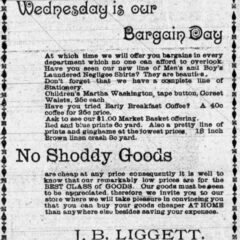
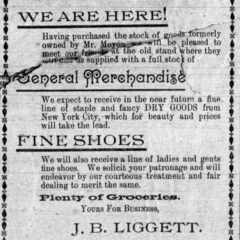
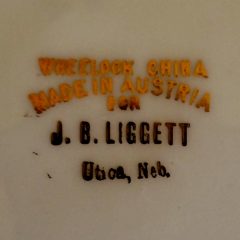
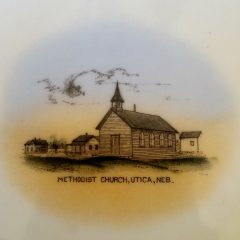
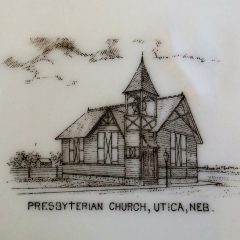
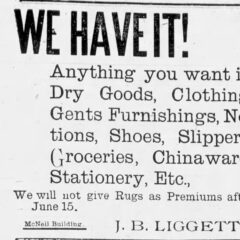
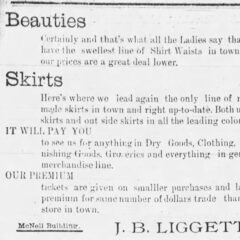
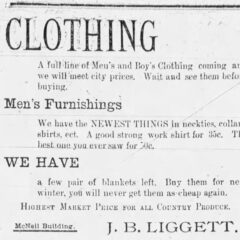
J.B. and Jennie Liggett continued to make frequent trips to San Diego, California, to visit her parents. The 1900 census shows that they were staying with the Warriners on Irving Avenue when their son was less than a year old. J.B. and Jennie finally moved to San Diego in 1907, but returned to Utica four years later. Below is a postcard picture of Jennie’s father, Harlan Warriner, sent to grandson, George Harlan, from San Diego to Utica by Jenny’s mother, Lucy, on July 10, 1906.
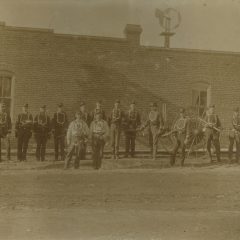
Utica Fire Brigade L to R: DJ Hartman, EL Hurlburt, JB Liggett, Jay Olives, John Harnes, SE Ragan, OD Thygeson, Otis Hunter, Wm Leichty, Ad Manweiler, RE Virgin, Tom Williams, DE Leonard. Front Row: Chief CL Swartz, Asst. Chief HA Colamore
While back in Nebraska, J.B. and Jennie nearly lost their house in a January 1911 fire that destroyed the Utica Methodist Church pictured on their china. “…Water was playing on the fire from two streams of hose but it was too late and was readily seen that the church building could not be saved at all. The firemen then turned their attention towards saving the residence of James Liggett on the east side of the church building…After the fire alarm had been sounded, people assisted James Liggett with moving all of the furniture out of his house…the firemen did good work in keeping the flames away so that not much heat would get near the building, others throwing water on it to keep it moist at all times. After the flames had been subdued, friends of the Liggetts assisted them to move back to their home. When the flames were burning the fiercest, sandwiches and coffee were being furnished by the Ragan restaurant through the courtesy of James Liggett.” 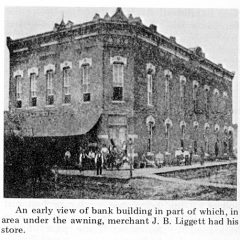
The fire may have been the final determinant of whether they would live in Nebraska or California, because by Sept. 1911, Jennie and Harlan were living with her parents.  James Bela wrote letters to Jennie about selling their house and furniture in anticipation of moving to San Diego. Jennie’s parents had a farm in nearby La Mesa, which is pictured above.
James Bela wrote letters to Jennie about selling their house and furniture in anticipation of moving to San Diego. Jennie’s parents had a farm in nearby La Mesa, which is pictured above.
Letter dated Sept. 30, 1911:
“Dear Jen, Yours of the 25th just received and I will try to answer tonight. I sold the piano now if I can sell the house we will be ok. I am nearly all packed and think I will get away Thurs. If I do will be there Sun. or Mon. That place Elliot has sounds good to me but of course will have to see it. I don’t think I want Mrs. Morris place even at the loan for. I know I can do better. I am sorry to hear Mr. Wilkens is not well hope he is ok by now. It is an awful quere fall rainy and fog all the time but not wet after all. Just enough to bother. It has fooled along all day and the ground isn’t even muddy. Pa and Geo have got their bathroom started. I think it will look real well when they get it done. Geo. had got to go back to Omaha for a few days next week to help the firm get out the statement and then he will be home to stay. All the men are through sewing wheat and it never looked better than now but of course the winter may make lots of difference. I guess I will have to paint and paper the whole downstairs since we got tore up. It looks like it needed it but I guess we’ll hire Hess. Got a letter from Aunt Vice today saying Jesse was not so well and was going to Denver to a sanitarium. Edith is teaching in the Perry school and Bernice is going to school in the 4th grade. I think of plenty to write when not writing but it all flies when I want it. Tell Hattie I will her peel her face when I get there my whiskers will be just right. I will take Mrs. Thygeson’s things to Leibees when I have the freight hauled. I hope business is better since Harry got home and they can cut expenses so they at least come out even. I have changed the papers all so you will begin getting there soon you should be getting the News now for it doesn’t come here. Well I will close and will drop you a card as soon as I am sure when I start. Hoping this finds everybody well. I am lovingly yours, Jim.”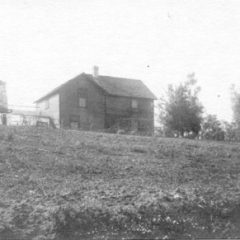
The land of sunshine, oranges, and beaches was heavily promoted by the railroad and other corporations selling land in California to midwesterners as a place full of health and opportunity.
J.B. and Jennie may have also moved there because of the warmer climate. Jennie died later that year, on September 24th, 1912, at the age of 38, of gastritis, while taking care of J.B.’s mother, Georgianna. 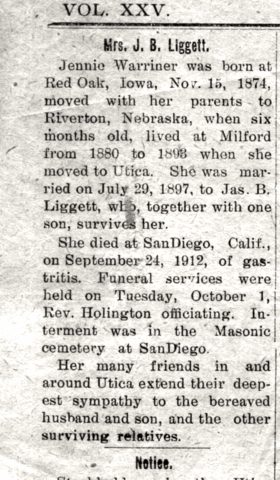
Their son and my grandfather, George Harlan, was only 13. Growing up in both Nebraska and California, he and his father, pictured below, “would bachelor together for a while, eating raw hamburger and onions.” 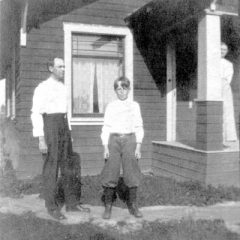
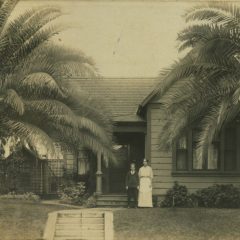
George Harlan and Hattie Liggett, Dec. 20, 1914, in front of their house at 519 14th St., San Diego, CA
When George Liggett Sr. died two years later, in October 19, 1914, his wife, Georgianna, called their son, George Jr., back from Omaha to run the family banking business in Utica. First son, James Bela, inherited some of the Nebraska farms and $50,000. A few months later he married Jennie’s devout Methodist cousin, Hattie (born Dec.25, 1883 in Franklin, NE), in Escondido, on Dec. 2, 1914. He also quit his job as a shoe clerk at Marston’s and used his inheritance to seek his fortune in real estate. Mrs. Richmond wrote this glowing article for the Utica Sun about a 1915 trip to San Diego to see the Liggetts.
In business as Liggett and Stelzer, an architectural and building firm at 730 E Street, in San Diego, J.B. Liggett and his partner, architect Louis A. Stelzer bought, developed and sold agricultural and commercial income properties in California. The Oct. 7, 1921 issue of Southwest and Contractor noted in San Diego that “JB Liggett and LA Seltzer had a contract to erect a $25,000 auto and service station at 7th and Market Sts. for James P. Laursen. Brick, hollow tile, and reinforced concrete construction with with comp rfg.” In addition to his father’s farms in Nebraska, he also invested in stock, oil wells in Louisiana, made loans, and invested in a variety of other endeavors. He had a ranch in Fallbrook, orchards in Meadow Vista, a farm in Palm City with 200 chickens, and Southern Lumber Company at 1301 S. Highland Avenue in San Diego.
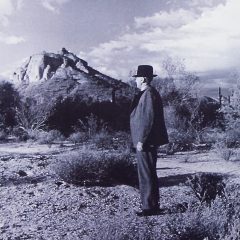
J.B.’s interest in the California real estate boom is shown in a letter to his son, George Harlan, dated Jan. 31, 1927, “when Boulder Dam goes in this land will go to $500 an acre and in time much higher.” He built apartments in Los Angeles and in San Diego where they are still standing at 26th and B St. He invested in the inventions of Bill Thompson, including one of the first mobile radios purchased and used by the San Diego Police Department.
“We have our radio working fine now and will soon see whether it will sell. Have several people who have waited until we could make them and now they want them demonstrated Thompson is working on a smaller design that will ship much easier and a new tube is coming out that will be of big benefit to us and cut out some of the heavy equipment.”
J.B. Liggett and his second wife, Hattie, had a daughter, named Anna (after his mother), on born March 31, 1920, in San Diego. Anna remembers that they took annual car vacations to see relatives in Nebraska or Washington. J.B. writes to his son, George Harlan, after a trip to Nebraska in 1927, “we had a very good trip but lots of punctures, had five from Shelton to Cheyenne and one every day on the road from there home.”
J.B. Liggett did not attend church services with his wife, Hattie, but enjoyed socializing and would go to the parties at the Methodist Church on 9th and C streets. Hattie also didn’t drink beer on their trips to Tijuana during Prohibition. This was a popular destination for visitors and relatives at the time. J. B. is pictured below, third from the right, on a trip there to celebrate Clarence Wahl’s 22nd birthday in July 1926 with six-year-old daughter, Anna, and her cousin, Virginia Wahl. (Clarence was the son of Pearl Liggett and grandson of Martin Liggett). 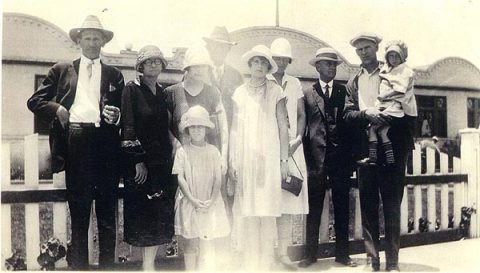
Martin and Ella Liggett had also moved west from Nebraska. First to Colorado, with their daughter, Pearl, and son-in-law, Claude Wahl and their two children, Clarence and Berneice, after Ella’s father, Harry Tuttle, died. Martin and Claude homesteaded adjoining portions of Section 20 in Township 11 north of Range 60 west near Grover in April 1914 to make a living in cattle ranching. Martin, at age 68, had a land patent for the southeast quarter of 160 acres. Claude had the west half of Section 20 which was 320 acres. Their property which was several miles northeast of Grover and still used for cattle grazing, is pictured below on the right. The original well and homestead foundation stones are also pictured below.
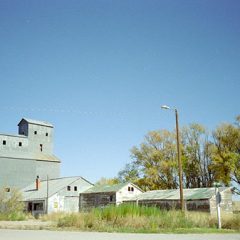
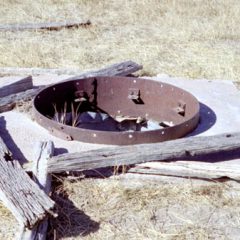
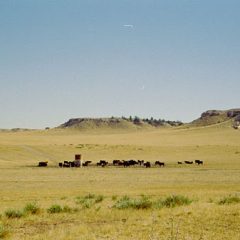
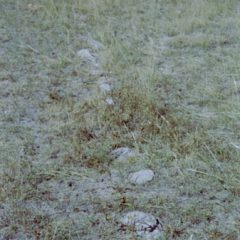
The completion of the Colorado and Wyoming railroad from Nebraska to Cheyenne spurred development of towns and more risky “dry land” farming beyond the South Platte Valley in what would be labeled by the National Weather Service as hail alley. The Lincoln Land Company filed a plat for the town in 1888 and Grover was incorporated in 1916 with a population of 250. By 1920, a new school and electric and water plants were built. During the boom, there were 37 businesses, a newspaper, two daily trains, several church groups, an opera house, hotel, and attorney. Pearl and Claude’s son, Clarence, met and married Ora Rhoads in the area. Their daughter, Virginia, was born in nearby Hereford in 1923. The same year, Ella Liggett and the Wahls moved further west to California. There is no record of Martin coming with them and the move may have been initiated by his death in Colorado. His last known record is the 1920 census for the Grover/Hereford area. Ella lived with the Wahls until her death in 1939. The railroad line through Grover has since been abandoned, as well as, the grain elevator pictured above.

Sweetwater Reservoir near San Diego, CA Dec. 9, 1928 Back Row: Hattie Liggett 3rd from left, JB 3rd from right. Front Row: Anna Liggett 3rd from right; Cliff Hurlburt far right.
Clarence and Ora Wahl had three more children in California: Chesney, Donald, and Vern. Anna Liggett has many memories of her family visiting with the Wahl’s, especially Virginia. Anna later graduated from San Diego State University in 1942, majoring in geography and anthropology. She married Ward Lyle Johnson the same year, on Feb. 7. They had a daughter, Sally, born in Santa Cruz, California, while Ward was working on the beach patrol during World War II. Sally married Virgil Chapin in 1962 and their son, James, now has a daughter, Ashley.
J.B. Liggett and Bill Thompson were both driving new black 1947 Cadillacs with engines modified by Bill, when Jim passed away on October 16, 1948, at the age of 74. (Pictured right: J.B. Liggett and his grandson, James Guinn, in 1948.) He was buried next to his first wife, Jennie Warriner, in the historic Mt. Hope Cemetery. The Nebraska farms were passed on to his sons.
Hattie Liggett remained in their home at 3510 Park Boulevard near the San Diego Zoo, giving subscriptions of the “ZooNews” to her grandchildren for Christmas. She remained active in the First United Methodist Church in its new Mission Valley location as treasurer of the “Doers” Women’s Circle and of her Sunday school class. Hattie Liggett was laid to rest with J.B. in Mt. Hope Cemetery when she passed away on Nov. 13, 1973. Pearl Liggett Wahl passed away a month earlier, on October 14, at the age of 95, in Buena Park, California.

